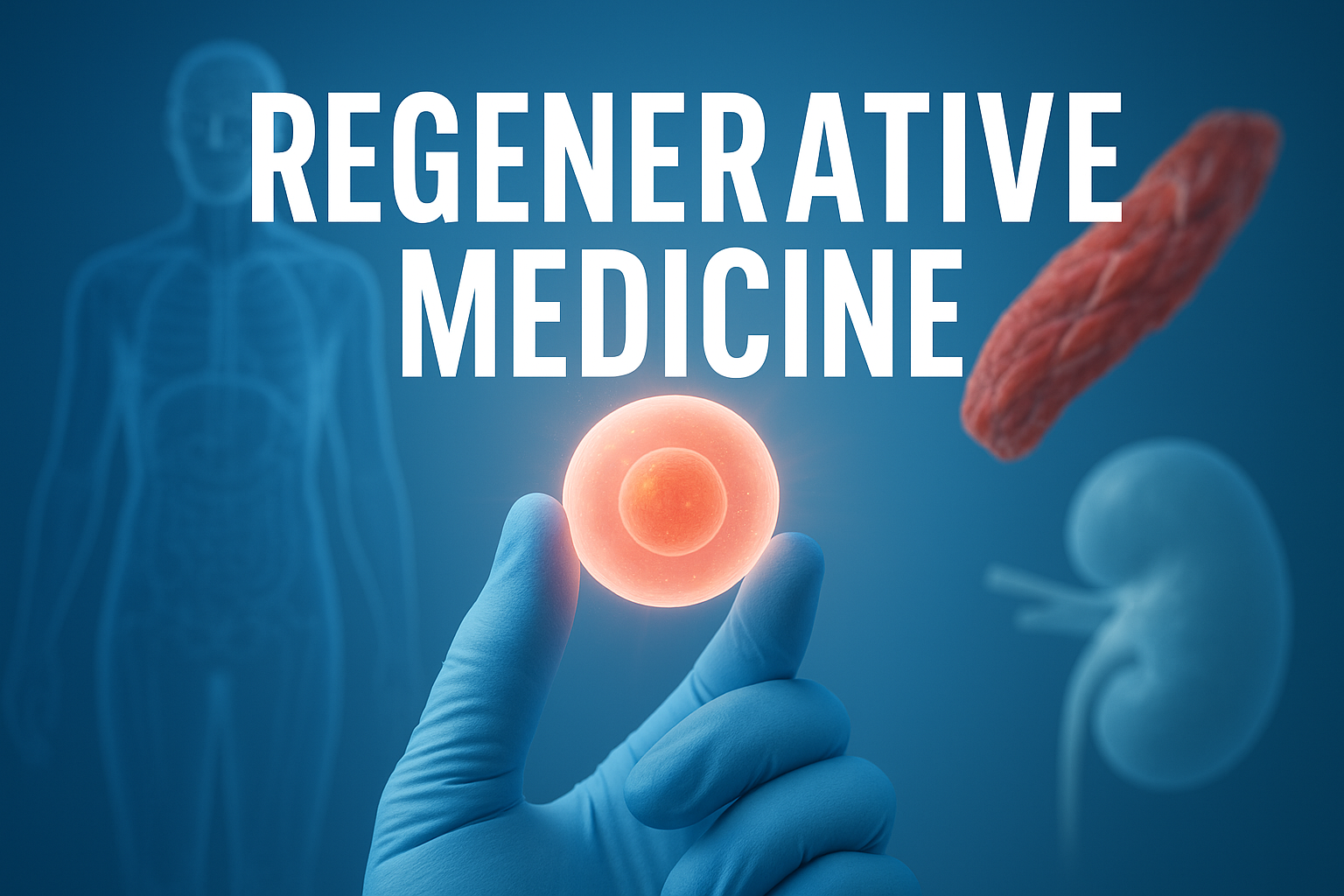Regenerative medicine represents one of the most revolutionary fields in modern science — an area that seeks not just to treat diseases but torestore, replace, and regenerate damaged cells, tissues, and organs. Unlike traditional medicine, which primarily focuses on symptom management, regenerative approaches work at the biological level to heal the body from within.
What Is Regenerative Medicine?
Regenerative medicine is a multidisciplinary field that combines biology, biomedical engineering, genetics, and materials science to restore lost function. Its core aim is to repair or replace damaged human cells, tissues, and organs, enabling recovery rather than long-term symptom management.
1. Stem Cell Therapy: The Cornerstone of Regenerative Medicine
What Are Stem Cells?
Stem cells are the body’s master cells, capable of developing into many specialized cell types — such as muscle, nerve, or blood cells. They are vital in growth, maintenance, and repair.
Key types of stem cells include:
- Embryonic Stem Cells (ESCs) — pluripotent cells that can form nearly any cell type.
- Adult Stem Cells (ASCs) — found in tissues like bone marrow and fat, typically multipotent and responsible for regenerating specific cell types.
- Induced Pluripotent Stem Cells (iPSCs) — adult cells reprogrammed to a pluripotent state, offering ethical and practical advantages for research and personalized therapies.
How Stem Cell Therapy Works
Therapy commonly involves harvesting stem cells (from a donor or the patient), processing them in a lab, and reintroducing them into the injured or diseased area. There they can differentiate into the required cell types and secrete factors that stimulate regeneration.
Applications of Stem Cell Therapy
- Degenerative diseases — osteoarthritis, multiple sclerosis, and neurodegenerative conditions are being explored for cellular reversal or stabilization.
- Cardiac recovery — regenerating heart tissue after myocardial infarction.
- Diabetes — generating insulin-producing cells to treat or cure type 1 diabetes.
- Spinal cord repair — restoring neurons and support cells to recover motor function.
- Cosmetic and rejuvenation — skin regeneration and anti-aging treatments.
2. Tissue Engineering: Building Living Structures
Tissue engineering combines cells, scaffolds (biomaterials), and growth factors to create functional tissues that can be implanted to replace or repair damaged structures. The process involves sourcing cells, designing scaffolds that mimic the extracellular matrix, seeding cells onto those scaffolds, and maturing tissue in controlled conditions.
How Tissue Engineering Works
- Cell sourcing — collecting healthy cells from the patient or donor.
- Scaffold creation — creating a 3D structure from biomaterials to support cell growth.
- Cell seeding — placing cells onto the scaffold so they can proliferate.
- Growth & maturation — culturing the construct until it becomes functional tissue.
Applications and Innovations
Current and emerging uses for tissue engineering include:
- Skin grafts for burns and chronic wounds.
- Cartilage repair for joint injuries and degenerative disease.
- Vascular grafts to repair or replace damaged blood vessels.
- Organ patches to repair portions of the heart, liver, or lungs.
Cutting-edge tools
3D bioprinting enables layer-by-layer construction of tissues using bio-ink (living cells + biomaterials). Smart biomaterials respond to environmental cues and release growth factors, while nanotechnology improves cell interactions and regeneration efficiency.
3. Organ Regeneration: The Ultimate Goal
Organ regeneration aims to grow whole organs or restore organ function using a combination of stem cell biology, tissue engineering, and advanced biofabrication. The vision is to eliminate organ transplant shortages and immune rejection events by using patient-derived cells.
Common Methods
Decellularization removes cells from a donor organ, leaving a protein scaffold. This scaffold can then be repopulated with the patient’s stem cells (recellularization) and matured in a bioreactor before transplantation.
Progress So Far
- Laboratory-grown bladders and tracheas have been successfully implanted in patients.
- Cardiac patches and liver organoids show therapeutic promise in early trials.
- Kidney and lung regeneration remain active areas of research with encouraging preclinical results.
Role of AI & Robotics
AI and robotics provide precise 3D modeling, automated bioprinting, and predictive simulations that optimize growth environments — accelerating translation to clinical use.
Challenges and Ethical Considerations
Despite rapid advances, regenerative medicine faces significant hurdles:
- Ethical concerns — especially surrounding embryonic stem cells.
- Immune rejection — ensuring compatibility and preventing adverse responses.
- Cost & access — therapies are expensive and not yet widely available.
- Regulatory complexity — balancing patient safety with innovation speed.
- Scientific limits — replicating complex organ structure and function remains challenging.
The Future of Regenerative Medicine
With advances in gene editing, biomaterials, and personalized stem cell therapies, regenerative medicine is moving from theoretical promise toward practical, widely available treatments. Future milestones likely include:
- Reduction of organ transplant waitlists via lab-grown organs.
- Improved therapies for chronic diseases like diabetes and heart failure.
- Personalized regenerative treatments based on a patient’s genetic profile.
- Longevity and quality-of-life improvements through cellular rejuvenation.
Conclusion: Healing the Future, One Cell at a Time
Regenerative medicine is more than a technological advance — it’s a paradigm shift in healthcare. By focusing on restoration and regeneration, the field offers the potential to reverse disease processes and restore function lost to injury or aging. While challenges remain, the pace of innovation suggests a near future in which many conditions once thought irreversible become treatable, and organ shortages are drastically reduced.


